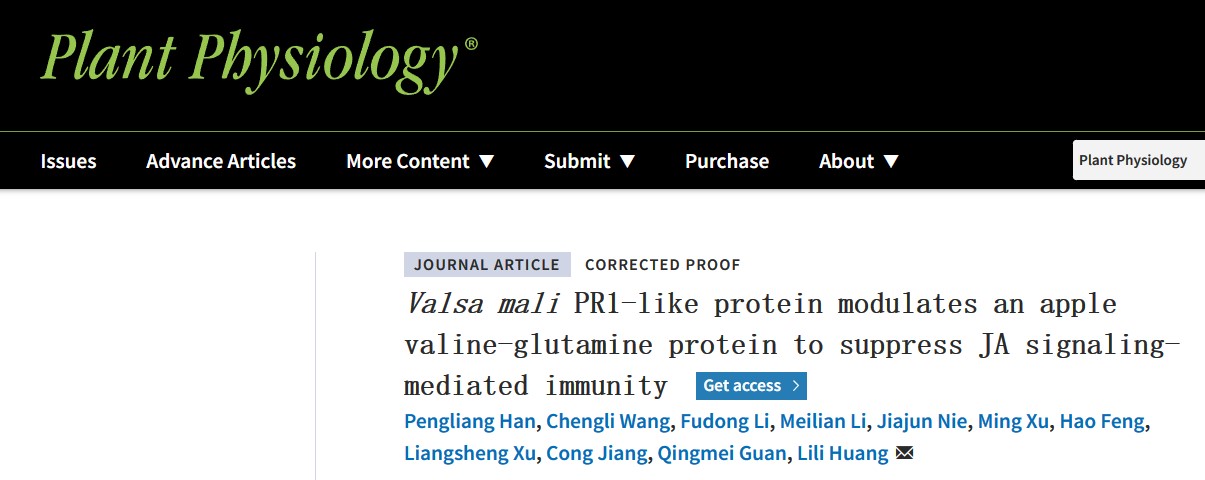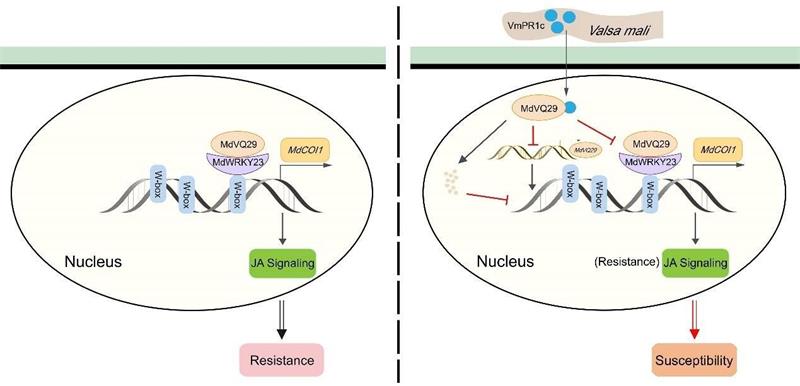Recently, the research team from our college published a research paper titled “Valsa mali PR1-like protein modulates an Apple valine-glutamine protein to suppress JA signaling-mediated immunity” in the journal Plant Physiology. This study reveals the molecular mechanism of the key effector protein VmPR1c of apple tree canker pathogen to interfere with host immune response by targeting apple VQ protein MdVQ29, and then promote the infection of the canker pathogen.

Apple tree canker caused by the plant pathogenic fungus Valsa mali is a devastating disease in apple production, which seriously threatens the healthy development of the apple industry. However, the research on the molecular mechanism of V. mali inhibiting host immunity leading to disease occurrence is not well investigated. Based on the previous systematic screening and identification of the key pathogenicity-related effector protein VmPR1c of V. mali, this study further analyzed its mechanism of action.
In this study, the target protein valine-glutamine (VQ) protein MdVQ29 of VmPR1c in apple was screened. The transgenic apple plants overexpressing MdVQ29 had significantly improved resistance to apple tree canker compared with the wild type. Further studies found that MdVQ29 interacts with the transcription factor MdWRKY23, promoting the transcriptional activation activity of MdWRKY23 on the jasmonic acid signaling pathway-related gene MdCOI1, thereby activating the jasmonic acid signaling pathway to exert disease resistance function. At the same time, the study also found that VmPR1c can inhibit the transcriptional activation activity of MdVQ29-mediated MdWRKY23 by promoting the degradation of MdVQ29, inhibiting the expression of MdVQ29, and inhibiting the interaction between MdVQ29 and MdWRKY23, thereby interfering with the host jasmonic acid signaling pathway and promoting the infection of V. mali. This study provides important genetic resources and theoretical basis for apple disease-resistant breeding, which has both scientific significance and potential production application value.

Schematic diagram of the regulation of apple disease resistance by the effector protein VmPR1c of apple tree canker pathogen targeting MdVQ29
Prof. Huang Lili of our college is the corresponding author of this paper, and the Ph.D students Han Pengliang and Wang Chengli are the co-first authors. The State Key laboratory for Crop Stress Resistance and High-Efficiency Production provided technical support for this study. This research was supported by the National Natural Science Foundation of China and the National Natural Science Foundation-Xinjiang Joint Fund Project.
Original link: https://doi.org/10.1093/plphys/kiae020